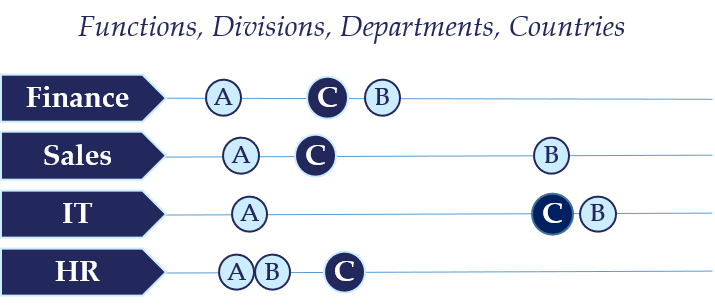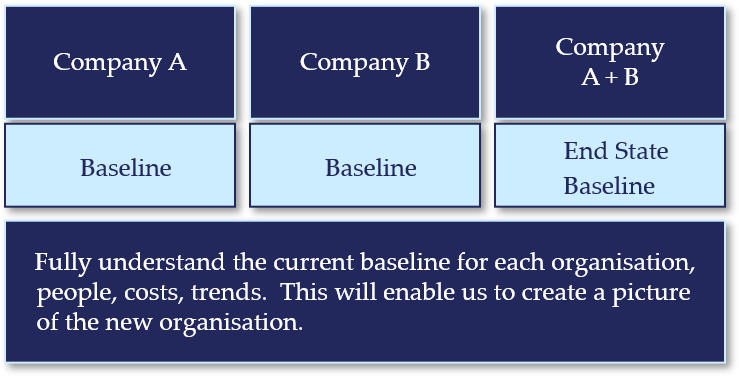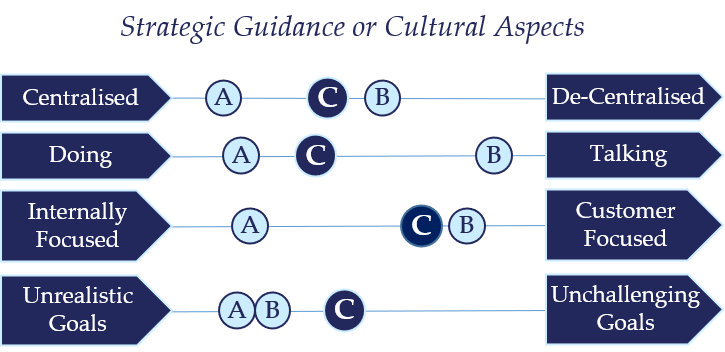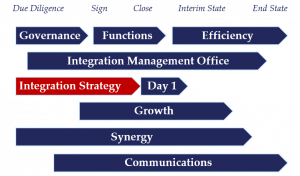What do you want the integration to deliver? A “light” integration where both businesses continue to develop operations separately due possibly to significant product and market differences ( vertical acquisition of a supplier or customer) can still deliver value by understanding each business’s maturity model and strategy for development. Whether it is a “light” or full integration the maturity models and the future strategic vision for both businesses and the combined business must be understood to ensure planning will deliver the desired end point.


Once we have a clear detailed understanding of current ways of working for the businesses and details of the end point, the IMO can ensure that there is a sound business case for the end point and that planning and timing will deliver it. Interim scenarios for Day 1, Day 90 and Day 180 can be prepared and road maps, milestones and potential roadblocks to delivery designed/assessed.
The medium and long-term strategy for the business must be robust under challenge, fit for where the business wants to be. An acquisition may be part of the strategy but, may also provide new opportunities for the business to grow and become more profitable, if current and desired future ways of working are not understood, mapped and reviewed integration value may be unrealised.


M&A Integration Strategy
For each part of the newly designed company you need to understand where the desired end state is. Taking a high level view of the company and then also each function, division, department, country and understanding where each part is today and where it should be in the future. Current state and end state wanted. Each company is A and B current state with C being the desired end state.
Once you have a clear detailed understanding of current ways of working for the businesses and details of the end point, the IMO can ensure that there is a sound business case and that planning and timing will deliver it. Interim scenarios for Day 1, Day 90 and Day 180 are prepared and road maps, milestones and potential roadblocks to delivery designed/assessed.


M&A Integration Mapping
A more detailed level of the Integration Strategy is the mapping process where we gather as much information as we can on the current state for each company, complete lists of customers, suppliers, people, IP, raw materials, plants, technology hardware and software, with all appropriate information to enable good comparisons to be made. For some areas actual maps will be draw e.g. properties, warehouses, customer locations, etc., and some will be diagrams e.g. IT systems or application maps.
With good up-to-date current information we can make a number of scenario for each area and ensure that how decisions in one area will affect the scenarios of another. We gain agreement on which scenario we like and the desired end state, then plan Day 1, month 3, month 6, to get to the end state scenario.


End State Selection for our deal
As part of the integration strategy process we need to ensure we have correctly stated each scenario, costed, planned and then put through the correct governance process. Remembering all the different scenario’s need to work together and add up to the right cost and synergy delivery for the deal.
Getting into the detail of each scenario (where appropriate) enables us to know what we are actually making decisions on, no surprises later, the devil is in the detail.


Baselining across the deal
To gain a good understanding of where we are today and ensure that we have changed or moved to the end state, a good understanding of what each company looks like today. This is a more detailed view of systems, process, data and its quality, together with detailed costs and understanding of what each division, function, business area looks like.
The aim is to answer the question, have the synergies been delivered? How can you know once you have finished if you don’t know where you started.


M&A Maturity Model
Many companies use this change and upheaval as an opportunity to review where they are and get better. All parts of our organisation my want to improve (or spend more money to change) we should only improve where it is useful to do so.
Are there areas we can change at little cost, given there is now a whole lot of new knowledge and experience in the other company?
We look at each part of the newly deigned company, and decide how good we want to be at that thing. Remembering that all the pieces need to fit together and that the new “end state” organisation may want to be better at some things that the previous parts, or may wish to reduce spend on some areas.


Cultural Aspects in mergers
We have been comparing the companies in what they do, we should also understand and compare how they work. Enabling us to decide where we want to drive the organisation and what are the key issues to focus on.
We might have open discussions in the way we want to work and treat people, and how these things fit with all the new changes in the business due to the merger. How should we work and how might we want to in the future? As with the other parts of the integration we will want to know current states and design future states.
To do this we might want surveys across the companies today and then at timely moments in the future.
Prepare survey and workshops, define survey participants wanted. Have a meeting to validate the survey questions, concepts and ideas. Finalise the survey or surveys (translate them into other languages if needed). Will it be paper, or in xls, or on a intranet web page. Build it in the appropriate format.
Have managers complete and return the survey. Provide contact point for questions, queries and chase returns. Collate results, prepare presentations and report output, and populate report, Draft report validation, Final presentation and report.




